Five Women Lead Renowned Forensic Anthropology Center
Originally published on UTK News.
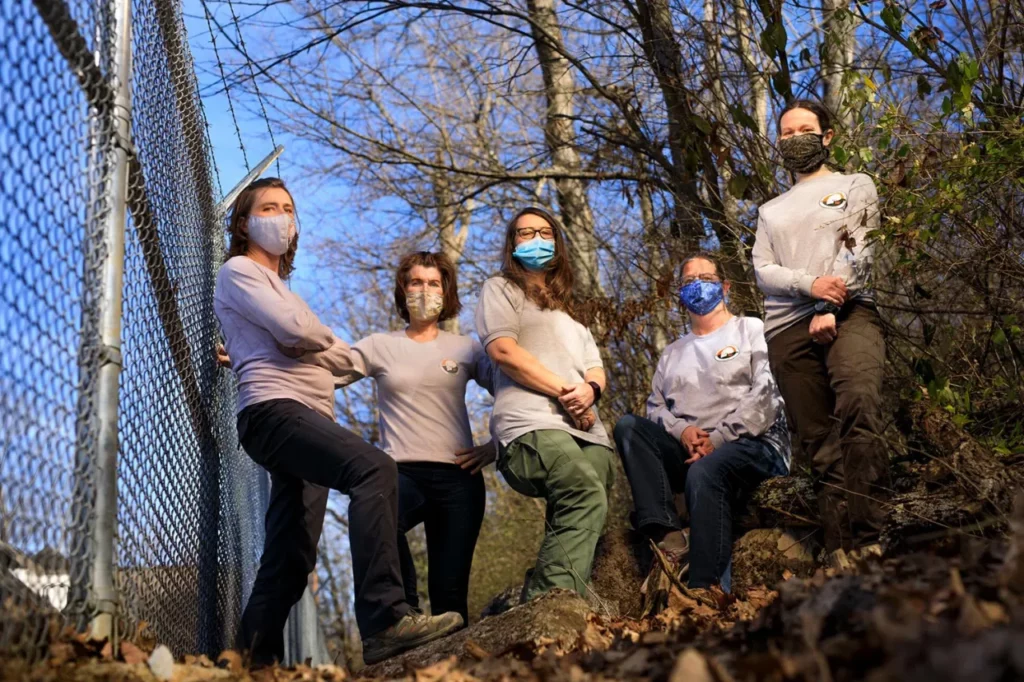
Every day, the red phone rings at the University of Tennessee, Knoxville’s Forensic Anthropology Center. Either Dawnie Steadman or Mary Davis, who share phone duties, answers. On the other end, a funeral home director, a police officer, or a family member shares with them some version of the same message: There’s a body here for you.
“That’s our death notification,” said Steadman, the FAC’s director. “That starts the process.”
The bodies belong to donors—one of the more than 5,000 people who have arranged to give their body for scientific study after death. Preregistration and infectious disease status are checked first. Then the FAC places calls to doctors and hospitals to request medical records. If everything checks out, a two-person team of graduate students drives to retrieve donors within 100 miles of Knoxville.
Donors are not the only bodies the FAC receives at its facility in the William M. Bass Forensic Anthropology Building on UT’s campus. At any given time, upwards of 40 forensic cases are handled for law enforcement by the FAC, which has contracts with the medical examiner’s offices of Kentucky and West Virginia and has consulted on cases as far away as the United Kingdom. In 2018, two of the center’s associate directors, Lee Meadows Jantz and Joanne Devlin, helped identify the remains of a 20-year-old Indiana woman who had been missing for more than 30 years. Not long afterward, a skeleton that had been at the facility since the 1980s was identified as that of a 15-year-old girl from New Hampshire who had run away from home and been murdered.
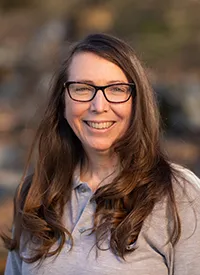
“When you wake up in the morning, you have your little to-do list,” said Davis, FAC assistant director and research associate. “You might as well throw that list out the window.”
The FAC is led by a team of five forensic anthropologists: Steadman, Davis, Jantz, Devlin, and Giovanna Vidoli.
“There’s this idea some people have that too many women can’t work well together,” said Vidoli, also an associate director for the FAC. “We’re all alphas in some way, which is exactly why we work well together. We trust each other to do the job.”
The FAC conducts national and international forensic investigations, trains law enforcement officers at every level in human remains identification, and oversees the Anthropology Research Facility—commonly known as the Body Farm—with as many as 200 decomposing bodies or skeletal remains. The center’s groundbreaking research on what happens to the human body after death has helped solve previously unsolvable crimes. And on top of it all the women who lead the FAC provide undergraduate and graduate students with invaluable hands-on experience in forensic anthropology, preparing them for the field in ways that few other university programs can.
The Body Farm and Beyond

On the outskirts of campus in the woods beside UT Medical Center, Professor Bill Bass (now professor emeritus) and his graduate students in 1981 built the world’s first outdoor research facility to study what happens to human bodies after death. Six years after the outdoor facility was created, the FAC was established within the Department of Anthropology. Since then, it has made headlines, helping to inspire a long list of books and television shows like CSI: Crime Scene Investigation and Bones. At one point, nearly two-thirds of board-certified forensic anthropologists in the United States were trained by Bass.
Around the time the FAC was emerging as a leader in forensic science, Steadman was an undergraduate at the University of Arizona. Originally a premed major, she had attended a lecture by Walter Birkby, a nationally recognized forensic anthropologist, and switched academic tracks. Birkby spoke about the techniques he used to identify victims after a tragic plane crash in Denver, Colorado. Thanks to his work, the families of the dead were not left wondering what happened to their loved ones. Their remains did not end up in indistinguishable common graves but were returned to their families.
“It’s not closure—but even if it’s the worst answer a person could possibly receive, families want to know what happened to their loved ones,” Steadman said.
Over the past three decades, Steadman has investigated mass graves in Argentina, Spain, and Uganda while working as a professor in Iowa and upstate New York and then at UT, where in 2011 she was named the FAC’s third director following the retirement of Richard Jantz.
Two of the five women who make up the FAC’s core team welcomed Steadman when she arrived. Jantz (’87, ’90, ’96) earned her bachelor’s, master’s, and doctoral degrees in anthropology at UT and has been with the FAC since it was established. “Lee is the living embodiment of our history,” Steadman said. Joanne Devlin (’96, ’02), director of undergraduate studies for anthropology, earned her master’s and doctoral degrees at UT and joined the faculty in 2004.

Vidoli arrived in 2013. A former graduate student of Steadman’s, she had run field schools in Colombia and worked mass casualty sites in Guatemala and Thailand and at the World Trade Center. Davis, the final member of the team, started the day before her birthday in 2017, leaving her job as a death investigation specialist for the Georgia Bureau of Investigation to join the FAC.
“I had never even been on campus before,” Davis said. “Everyone in the field knows about the research coming out of UT. I couldn’t pass up the opportunity to work here.”
Over the years, each member of the team has carved out their own lane in order to manage the daily workload of running the country’s leading university forensic anthropology center. Steadman directs research and communications with partners like the National Institute of Justice. Vidoli organizes courses and trainings for law enforcement and oversees quality assurance. Jantz works cold cases and oversees the Bass Curated Skeletal Collection, which consists of 1,800 skeletons and is stored in Strong Hall. Devlin is the generalist, doing, in her words, “whatever needs doing.”
“A day at the FAC is like juggling all these different things above you in the air,” Devlin said. “The most important thing is the one that’s about to fall and hit you in the head.”
The FAC’s yearly trainings have attracted an international group of forensic anthropology students, law enforcement personnel, and scientists to refine a range of skills including excavating burials, distinguishing bones, and estimating time since death. Since 1999 the FAC has provided yearly training for the FBI’s Evidence Response Team. Later this year, a team of Mexican forensic scientists working to uncover mass graves from cartel murders will be in Knoxville to learn from the FAC team.
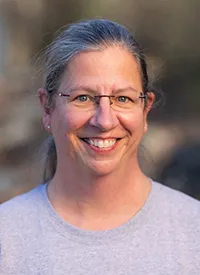
But the FAC may be best known for its expansive body donation program, which surged with the crime scene television shows of the 2000s. By 2009, the FAC was receiving more than 120 donors a year.
Davis oversees the front end of the program—the first contact for many families and individuals donating bodies. A significant portion of her job is spent answering their questions.
“They may be scared or curious or they just need someone to talk to,” Davis said. “If somebody is giving us the gift of their body, the least I can do is give a half an hour, 45 minutes of my time.”
Once bodies arrive at the FAC and are placed outside, they may take weeks to months to fully decompose. After the remains are brought back inside and stored in the skeletal collection, Jantz is responsible for communications with families of donors. On the day of a scheduled visit, she prints out a history of the trainings and research the donor supported and brings it to the family viewing the remains.
“One gentleman came in, and we have both of his parents,” Jantz said. “The mother had died from cancer and his father in a house fire. He felt like he had never had a chance to say goodbye.” Jantz was able to provide that for him.
There are also out-of-the-ordinary cases.
“I had one family visit, children to great-grandchildren, and they had made T-shirts for the occasion,” Jantz said. “They were ecstatic. They wanted me to lay out the skeleton, to touch it.” Before leaving, they purchased all kinds of merchandise the FAC sells to support its research.
A Gender Shift in Forensic Anthropology
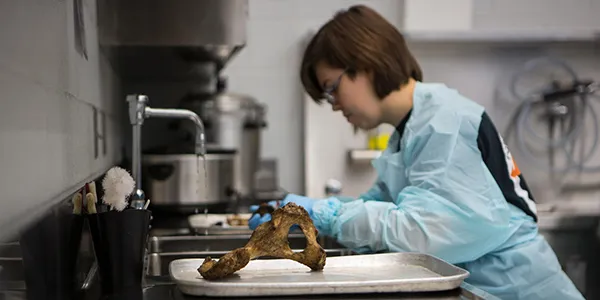
Compared to the 1980s, when Steadman and Jantz were in school, forensic anthropology has become an increasingly woman-led field. Of the nearly 40 graduate students currently working with the FAC, only three are men. The women of the FAC all have their hypotheses for why.
“It is possible women continue to be implicitly or explicitly turned away from the hard sciences,” Steadman said. Before switching majors as an undergraduate, Steadman had been boastfully told by a chemistry professor that he had never before given a woman a passing grade. “It was the only C I ever got, but I passed.”
“On the flip side, we know the women in our program are drawn to social issues like criminal justice and human rights,” Steadman said. “This is a field where you can be science-minded and also pursue justice for families. You can provide answers to them.”

In 2019 the department officially established a forensic concentration within the anthropology major. About a quarter of the department’s first-year students are enrolled in the concentration. Undergraduates can take courses in skeletal processing, skeletal collections and curation, and anthropological field recovery as well as a forensic trainee course that allows them to work side by side with researchers.
“When you leave here with a BA, you have had more hands-on opportunities at the outdoor research facility than people in grad programs at other institutions,” Devlin said. As body farms have expanded nationwide to universities in North Carolina, Texas, Illinois, Colorado, Florida, and Michigan, many facilities end up employing alumni trained by the FAC. Texas State, for example, has at least four former UT students.
While solved forensic cases and body donations may grab more public attention, the research coming out of the FAC has proven just as valuable, particularly for government agencies. The center will soon complete a project for the National Institute of Justice looking at the effect drugs have on human decomposition, including how and which insects feed on the body when different drugs are present. In 2019 Vidoli and Devlin received a grant to create a protocol for correctly identifying blunt-force trauma occurring before death, even after severe burning. The research is the first in which complete human bodies were impacted by blunt force. The FAC collaborated with undergraduate students from UT’s Tickle College of Engineering who designed and developed a device to inflict the trauma.
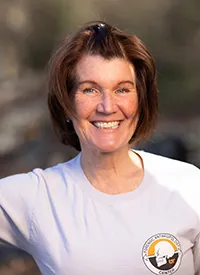
Even with a team of five, days at the FAC are long. The red phone rings two or three times a shift. Donors arrive week after week. Every semester, research is produced and investigations are closed. To keep the work moving takes trusting every member of the team to do their part. For Steadman, Davis, Jantz, Devlin, and Vidoli, that may mean literally being willing to put hands, knees, and bellies in the dirt beside each other—something they’ve proven over the years to be more than happy to do.
“In everything I suggest, whether it’s crazy or not, I know these women will support me, encourage me, and challenge me to be better,” said Devlin. “Maybe you can call that our approach.”
__
CONTACT:
Amanda Womac (865-974-2992, awomac1@utk.edu)